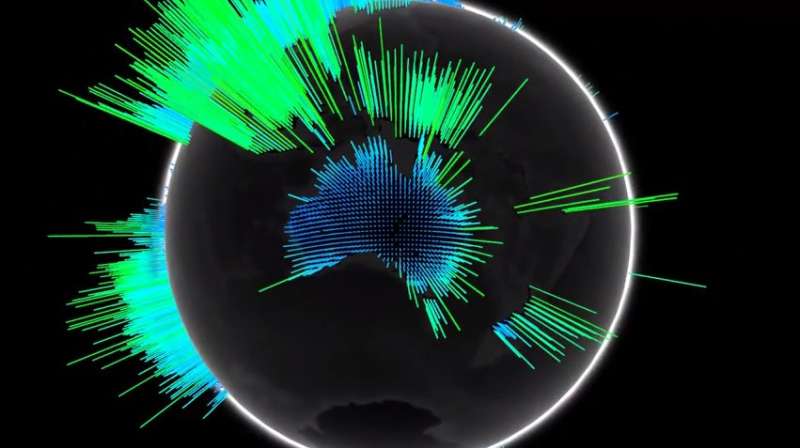Watching plant photosynthesis... from space

University of Sydney and NASA researchers have developed a revolutionary new technique to image plant photosynthesis using satellite-based remote-sensing, with potential applications in climate change monitoring.
The uptake of carbon dioxide by leaves and its conversion to sugars by photosynthesis, referred to as gross primary production (GPP), is the fundamental basis of life on Earth and its quantification is vital for research on terrestrial carbon cycle dynamics.
This new study, published in the journal Science, uses satellite-based monitoring to measure solar-induced chlorophyll fluorescence - a by-product of photosynthesis in leaves. Crucially, the study also shows how these fluorescence measurements correlate with GPP observations on the ground from diverse locations, areas of vegetation, and over various timeframes. This observed link between fluorescence and plant carbon dioxide uptake opens up many potential applications of this technique, such as for climate change and ecosystem monitoring, biodiversity conservation, and land management.
Dr Bradley Evans, co-author of the study and Senior Lecturer at the School of Life and Environmental Sciences, has been collaborating with NASA's David Schimel and his team to develop a more direct way of measuring plant growth using the Orbiting Carbon Observatory-2 (OCO2) satellite.
Dr Evans commented that "The OCO2 satellite created such an amazing opportunity, and particularly when we discovered a significant relationship between the fluorescence of plants and the satellite imagery.
"We're really excited by our results, and how they are a step closer to a quantitative estimate of the photons of light resulting from photosynthesis.
"We also hope that our results will help others to better quantify carbon flows, so that we can understand more about Earth's climate and ecosystem."
Dr Evans's research was enabled by the Sydney Informatics Hub (SIH), the University of Sydney's Core Research Facility dedicated to advancing high-performance computing, data science and open-access research data management capabilities.
"This work is a very impressive accomplishment, and publication in one of the world's most prestigious journals shows the importance of these results" said Dietmar Müller, SIH Director.
"It's great to see how Sydney's commitment to building a world-class informatics capability is already starting to enable our researchers to achieve truly great things."
More information: A. Eldering el al., "The Orbiting Carbon Observatory-2 early science investigations of regional carbon dioxide fluxes," Science (2017). science.sciencemag.org/cgi/doi … 1126/science.aam5745
Journal information: Science
Provided by University of Sydney




















